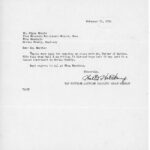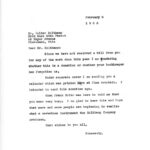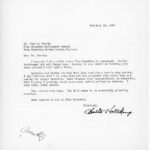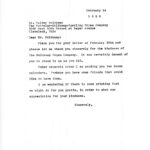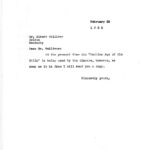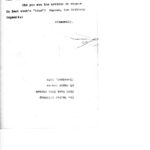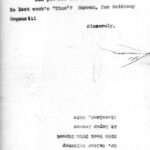Pine Mountain Settlement School
Series 10: BUILT ENVIRONMENT
Chapel
Charlotte F. Hedges Memorial Chapel
1922 – present
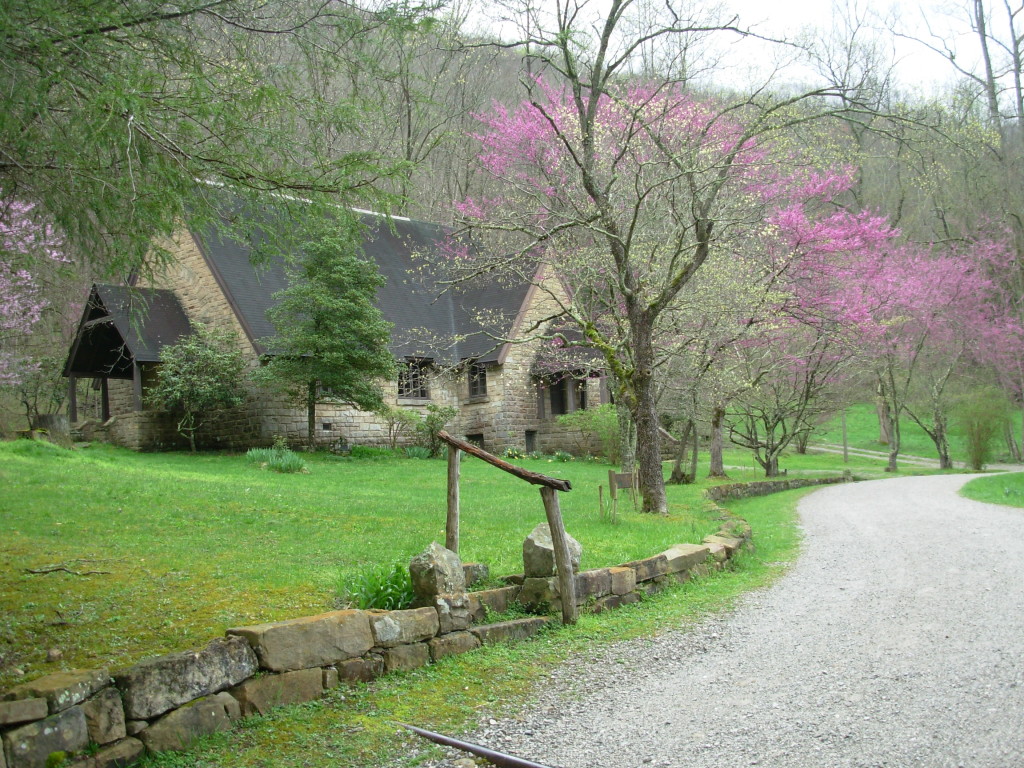
Chapel, Spring 2012. View from the east. [2012-03-23-05.47.00.jpg]
TAGS: Chapel, Charlotte F. Hedges Chapel, Mary Rockwell Hook, construction 1922, Luigi Zande, Jesse Munger, Holtkamp Organ, vespers, non-sectarian churches, window restoration, James Turner, Rev. A.L. Wilson, The Perfect Acre, Leon Deschamps
CHAPEL Charlotte F. Hedges Memorial Chapel
1922 – present
The Charlotte F. Hedges Memorial Chapel, constructed in 1922, is commonly known as “The Chapel”. Funds for construction were donated by Charlotte F. Hedges and the structure is more properly named the Charlotte F. Hedges Chapel after the donor. The niece of Charlotte F. Hedges (1810-1900) whose name was Jesse Munger, was a long-time friend of Pine Mountain Settlement School. It was Miss Munger who arranged for the School to receive a small fund from her Aunt and who later donated the funding for the Holtkamp organ now found in the Chapel. Through her Aunt’s endowment and her own gift, Munger left the Settlement School with one of the most exquisite buildings in Southeastern Kentucky.
CHAPEL: Funding, Design, Construction
According to Mary Rogers and letters of correspondence found in the Pine Mountain School archives, Munger offered to donate a small fund left to her by her aunt, Charlotte F. Hedges, plus some additional funds of her own to build either a house or chapel for the School. Ethel de Long Zande responded by suggesting a chapel and library. Miss Munger did not want the library included and requested the funds be used specifically for a chapel. Ethel de Long then contacted Mary Rockwell Hook, the School architect, and asked that she develop plans for a small chapel. Several people, including Ethel de Long Zande’s husband, Luigi, suggested additions to the plans to Mary Rockwell Hook, but was re-buffed. With the aid of his wife, Ethel de Long Zande, he was most persistent. The result was a Roman arch above the altar area and not the triangular support imagined by Hook.
The other persistent voice that changed the original plan of Mary Rockwell Hook was that of Thomas B. Roberts, the Harlan minister who had been serving the School’s congregation as an occasional minister. The two individuals, Zande and Roberts persisted in making alterations in the plans drawn up by Mary Rockwell Hook.
The ultimate design, however, was that of Mary Rockwell Hook, the designated School architect. The most obvious alteration in the Hook plan was the rounded Roman arch, an interior departure from the original Hook plan. Hook reluctantly included the Zande alteration which stands in contrast to the multiple triangular arches that dominate the structure.
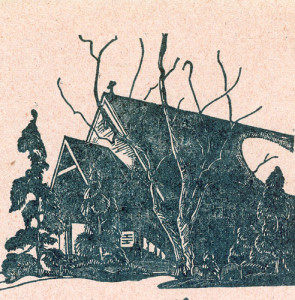
Chapel. Woodblock print by John A. Spelman III, c. 1940. [chapel_spelman_modified.jpg]
The building began in 1922 and, although used in the summer of 1924 with make-shift furnishings, the Chapel was not dedicated until November 12, 1924. The Reverend Alfred Lee Wilson, a Presbyterian minister from Ohio and a member of the Pine Mountain Advisory Board, gave the sermon, “What Religion Adds to Life.”
The 1924 Pine Mountain Notes describes the new Chapel:
It took two and a half years to build our memorial chapel, and those who worship in it were the builders of it. The stone-masons who laid its beautiful walls, the carpenters who fitted its beams and oaken woodwork and made its heavy paneled doors are our neighbors and learned their craft at this school. So the day when we gathered to dedicate this work of our hands was [a] high and holy one. Rev. Alfred Lee Wilson, of Canton, Ohio, conducted the service and preached on “What Religion Adds to Life.” Later, at an evening service he held for the boys and girls only, twenty-four of them told him of their wish to lead the Christian life, and the dedication day had its own meet offering.
Whenever the church bell rings it peals out the words that are cast in its bronze and sends them ringing down the valleys for all to hear: “Oh all ye children of men, bless ye the Lord; praise Him and magnify Him forever.
While this sounds like a sectarian revival meeting, Mr. Wilson wrote back after his visit and said:
The religious work, symbolized by the beautiful new church building is not sectarian, but vitally Christian, and the kind of Christian character your school is building into the lives of the splendid mountaineer boys and girls is a real contribution to the best life of America. In the language of our mountain friend ‘you’re puttin’ a powerful lick’ not only for education but for the Kingdom of God.’It is in this spirit that the doors to the beautiful Chapel are always open for any worshiper to enter.
In 1926 Jesse Munger and the Munger family visited the campus for what was apparently the first time. Ethel Zande writing to Mary Hook noted that the family was pleased with the design. However, she says “… they agree with many at the School that the chancel window is a bit bare and crude, and needs warming up.” She expanded on that:
Mrs. Munger is of the opinion that a colored, if not a stained glass window would be a help, even if it were just good amber glass. We are finding out that people here who go to church most, feel about it, and are secretly hoping that the improvement will come about in some other way. Meantime, we are going to have some nice curtains for that window, and after much talk on the subject we feel that they should be blue, the color of the long curtains the weaving department is making to hang at both sides of the chancel arch, and that they should be lined.
It is going to be a very fussy job to make them, and one we cannot undertake here. Whom could we delegate it to? Will you find us a good upholsterer or decorator who would do the job? We plan that they will operate as indicated in this sketch [sketch is missing], being pulled back so that the upper triangle of light will be excluded (it’s rather glaring in the morning, to have all that clear sky in one’s eyes), and yet have all the light possible from the lower panes. Won’t you make sketches of any ideas you may have on the subject?
The glass in the window is inferior too, which adds to the general failure of that window, but we are not going to put in good glass till we see how the curtain works or whether colored glass is to be put in.
There is no indication that Ethel Zande’s recommendations for the chancel window were ever adopted or approved by Hook. Possibly her remarks were motivated by recommendations from the Munger family or possibly by the competition or the failure of Hook to readily accept the design recommendations of Luigi Zande, Ethel’s husband. Or, perhaps, the simplicity grew to be part of the beauty. Whatever, the motivation, the spare interior remains the Chapel’s elegance.
CHAPEL: Valuation, Holtkamp Organ
In 1929 the insurance value of the building was $13,608.62. In the early 1940s, the building and equipment was valued at $17,760.00. The building is one story with a small basement where a furnace is located, a large open nave, and a small enclosed music library room in the apse to the left of the altar. The seating capacity of the Chapel is about 200. The Chapel also houses a unique and beautiful two-manual, 10-stop Holtkamp organ. The church is described as “unusually conducive to worship.” It has also been the site of numerous weddings, a tradition that continues today. For more about the Chapel organ, go to CHAPEL Holtkamp Organ.
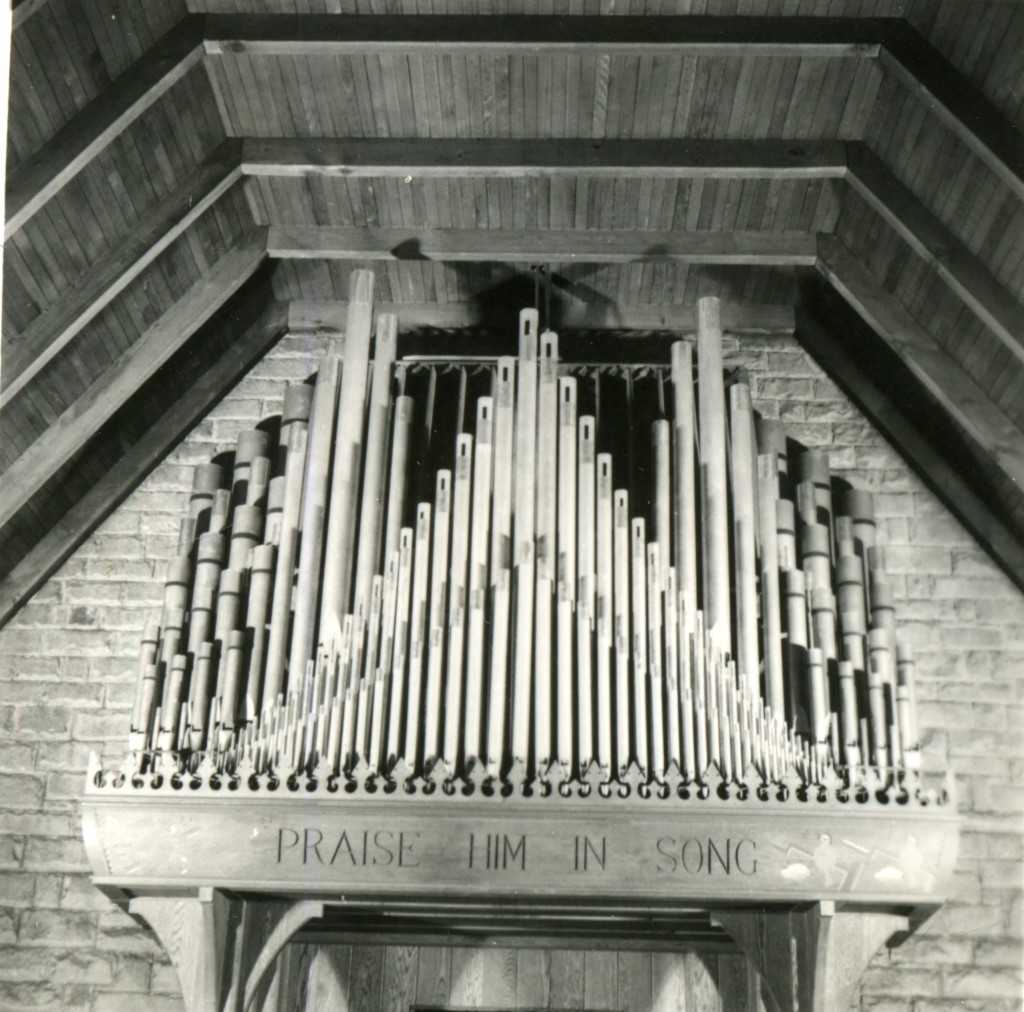
Holtkamp organ pipes in the rear of the Chapel. Dieter Album. [shul_007.jpg]
CHAPEL: Memorials
Ethel de Long Zande is buried next to the nave that faces the campus. In the transept to the left of the exit door are plaques of dedication to Ethel de Long and to Katherine Pettit, the School’s founders. The large bronze plaque for Ethel del Long Zande was given by the Montclair Pine Mountain Association and reads:
In Memory of the Radiant Leadership
and Inspiration
of
Ethel deLong Zande
in this School
1913-1928
Whatsoever things are true
Whatsoever things are honest
Whatsoever things are pure
Whatsoever things are lovely
Think on these things.
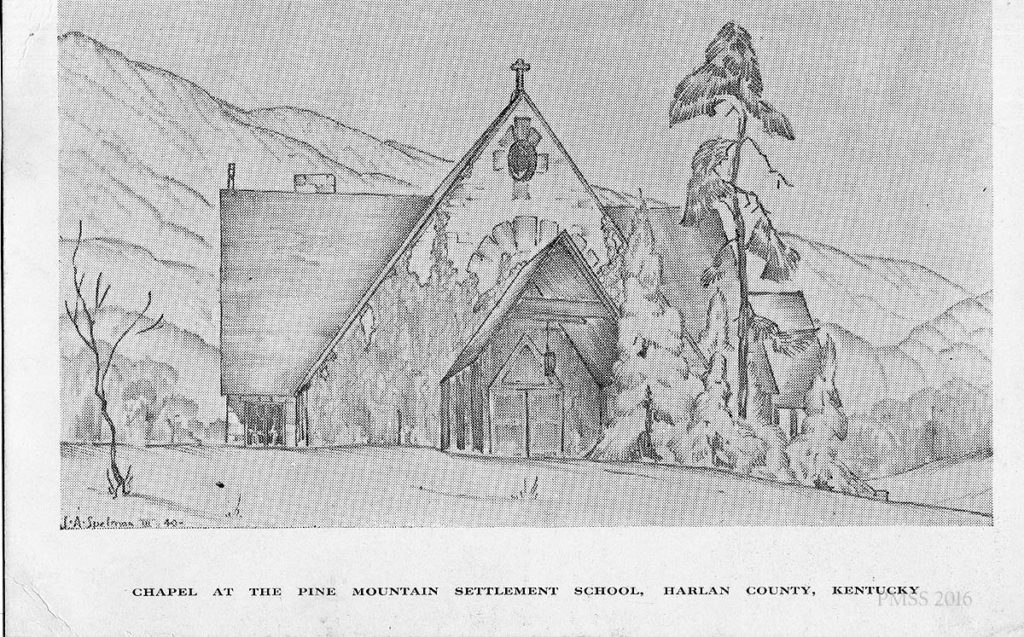
Chapel sketch by John Spelman III, c. 1940. Barbara Spelman Correspondence. [spel_b_012b.jpg]
In the 1944 issue of the CONIFER the graduating class wrote a lengthy poem about their years at Pine Mountain. The poem titled “How Beautiful Their Feet Upon the Mountain,” extols the many memories the School evoked. One particular section remembers the Chapel:
American Gothic— tall gables reaching skyward—
symbol of our aspirations toward all good, toward God;
This, our chapel, built of stone and timbers,
hewn from the strong mountain at its back.
Throughout our lives, we may close our eyes
and see it through the changing seasons:
In spring, bare dark branches burst alive—and behold!
a picture framed in the pearl of dogwood and rose redbud.
In summer, greenness of sloping lawn, climbing ivy,
balm of hemlock, shade of poplar.
In fall, the miracle of Nature’s final fling in riotous color,
mellowing to soft earth tones.
In winter, the purity, peace, and blessing
of white on ground, on roof, on bough.
Now the clear rhythmic call of the bell pulses throughout the valley.
We ascend the winding pathway;
silently the heavy, oaken doors swing open and close.
We are filled with a sense of warmth, protection, at-homeness
A wave of thankfulness for all that is ours,
for all that our chapel has meant,
and will mean to us and others,
wells up in our silent prayer.
The stone altar, simple and beautiful in moss, foliage,
and flower of Nature’s constant offering;
The cross, illumined in candle light.
A vesper hour with the masters—
Beethoven, Bach, Mozart, on organ, or piano;
Or with the poets— Coffin, Whitman, Bryant, Shelley, Keats.
Ardent young voices raised in song;
Prayer for the millions of God’s own
who are deprived of the good things of earth.
CONIFER 1944 – Class of 1944
CHAPEL: New Window in Chancel and Windows Restoration
In 1976 during the annual Homecoming at the School there was a Memorial Window Dedication in the Chapel. In late April a restored window was installed in the chancel (apse) to replace the badly deteriorated west-facing window. The Dedication of the restored window in the first week of May was marked by a special worship service and a worship service that memorialized Earl Brown, a former student of the School.
The work on the central window was the beginning of a progressive program over several years to restore all the wooden windows in the Chapel. Floor refinishing, furnace repairs, and other interventions have been necessary through time as the School and its supporters have repeatedly shown their affection for this unique, beautiful, and historic building.
PMSS Statement of Belief
At the close of the nineteenth century, the members of the Women’s Board of Home Missions of the Presbyterian Church were concerned that many Americans in isolated areas were not receiving a proper education. The women decided to establish or support church-related schools in areas where there were no public services. These schools were often referred to as “Mission Schools” and were sponsored by various denominations. Red Bird Mission is one such example of a “Mission” School.
Pine Mountain Settlement School did not draw on funds from any singular denomination and has never identified as a “Mission School.” As an institution it is not beholden to any one church and many religious beliefs have held a central place in worship services offered in this special chapel of worship. The School was founded on and has always maintained a non-sectarian stance and is not considered a Mission School centered on any one denomination.
The STATEMENT OF BELIEF , seen below and printed by Pine Mountain’s Print Shop in the 1940’s for the Pine Mountain Settlement School church congregation during the Boarding School years, puts forward the open religious position of the School established by the founders and informally adopted by succeeding administrations. The STATEMENT OF BELIEF was for the Church congregation comprised of staff and interested community during several periods of the School’s history. It does not describe the Chapel as Church. The Chapel has traditionally been used by many faiths and for life events such as weddings, Baptisms, Quaker fellowship meetings, Catholic Mass, devotional readings, and other spiritually inclusive gatherings — as well as private prayer. It is a Chapel for the million’s of God’s own, in service to the School for multiple respectful purposes and events.
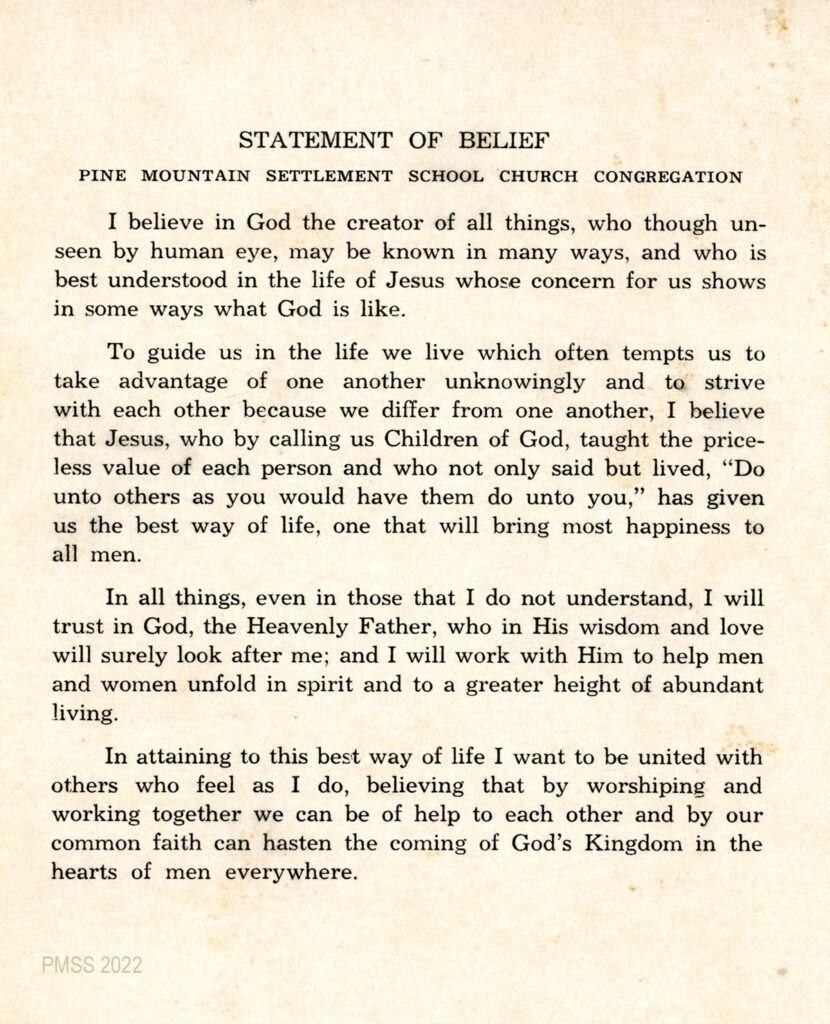
Statement of Belief of the Pine Mountain Settlement School congregation, n.d. PMSS Print Shop. [religion_statement_001.jpg]
Pine Mountain recognizes the distinction between the two places of worship, church and chapel, and their defining characteristics.
-
A church is a larger building and the main place of worship where Christian denominations, such as Catholic, Protestant, or Orthodox worship services, are held1. It is a place of worship with a permanent congregation and is run by a pastor or priest2. The people of a church are called congregants and schedule times to gather, worship, and study religion2.
-
A chapel, on the other hand, is typically a smaller building or a room within a larger institution like an airport, hospital, or university3. It does not necessarily have a permanent congregation or a designated pastor or priest2. Chapels can also welcome nondenominational or interfaith worship3.
In summary, while both are places of worship, the main difference lies in their size, the presence of a permanent congregation and clergy, and their inclusivity of different faiths.
CHAPEL: Nearby “The Perfect Acre”
Another place for the “Millions of God’s own”, is a small tract of land behind the Chapel, called “The Perfect Acre”.
Located behind the north flank of the Chapel is “The Perfect Acre,” a cultivated forest designed by Leon Deschamps to be, in his view, the best example of silvaculture. Deschamps began work on the site in 1917 when he came to the School to teach forestry to the children. The wooded site can still be viewed outside the windows of the north flank of the Chapel, and following the removal of the mature trees planted by Deschamps, little remains of his original work. [The mature trees presented a threat to the Chapel’s structure.] Nonetheless the current forest is a marvelous meditation.
See Also:
Deschamps’ “The Perfect Acre“
LEON DESCHAMPS Staff – Biography

Deschamps’ “Perfect Acre,” May, 2016. [pmss_archives_perfect_acre_2016b.jpg]
Gallery: CHAPEL
CHAPEL: Corrrespondence
Concerning the Holtkamp Organ
February, March, & November 1938
[For a LIST OF THE CONTENTS of this correspondence, go to CHAPEL Holtkamp Organ.]
- Holtkamp-001 1938_12_directors_reports_holtkamp_001
- Holtkamp-002 1938_12_directors_reports_holtkamp_002
- Holtkamp-003 1938_12_directors_reports_holtkamp_003
- Holtkamp-004 1938_12_directors_reports_holtkamp_004
- corres-005x 1938_12_directors_reports_holtkamp_005
- Holtkamp-006 1938_12_directors_reports_holtkamp_006
- Holtkamp-007 1938_12_directors_reports_holtkamp_007
See Also:
ALFRED LEE WILSON Rev. Trustee
Reverend, PMSS Trustee 1915-1920
CHAPEL Holtkamp Organ
PMSS NOTES 1924
RELIGION
RELIGION Guide
RELIGION Records of Church Memberships Baptisms Weddings I
RELIGION Records of Church Memberships Baptisms Weddings II
RELIGION Statements of Belief at Pine Mountain Settlement School
RELIGION Student Reflections on Religion at PMSS
Return To:
BUILT ENVIRONMENT
|
Title |
Chapel |
|
Alt. Title |
Charlotte F. Hedges Memorial Chapel ; The Chapel ; |
|
Identifier |
CHAPEL |
|
Creator |
Pine Mountain Settlement School, Pine Mountain, KY |
|
Alt. Creator |
Mary Rockwell Hook, Architect |
|
Subject Keyword |
Chapel ; Charlotte F. Hedges Memorial Chapel ; Pine Mountain Settlement School ; Pine Mountain, KY ; Harlan County, KY ; Jesse Munger ; Mary Rogers ; Charlotte Hedges ; Ethel de Long Zande ; Luigi Zande ; Dr. Thomas B. Roberts ; ministers ; Mary Rockwell Hook ; Reverend A.L. Wilson ; Presbyterians ; Pine Mountain Advisory Board ; basements ; furnaces ; music rooms ; naves ; apses ; altars ; Holtkamp organ ; gravestones ; transepts ; memorial plaques ; Katherine Pettit ; weddings ; churches ; |
|
Subject LCSH |
Chapel — Pine Mountain Settlement School (Pine Mountain, Ky.) — History. |
|
Date Original |
Dedicated November 12, 1924. |
|
Date Digital |
2013-09-11 ; 2013-09-17 ; |
|
Publisher |
Pine Mountain Settlement School, Pine Mountain, KY. |
|
Contributor |
Jessie Munger for Charlotte F. Hedges. |
|
Type |
Collections ; text ; image ; |
|
Format |
Original and copies of images/JPG, documents, and correspondence ; collection of photographs ; |
|
Source |
Series 10: Built Environment (Physical Plant) |
|
Language |
English |
|
Relation |
Is related to: Pine Mountain Settlement School Collections, Series 10: Built Environment (Physical Plant) ; Kentucky Virtual Library collections <http://www.kyvl.org/> [searchable] |
|
Coverage Temporal |
1922 – present. |
|
Coverage Spatial |
Pine Mountain, KY ; Harlan County, KY ; |
|
Rights |
Any display, publication, or public use must credit the Pine Mountain Settlement School. Copyright retained by the creators of certain items in the collection, or their descendants, as stipulated by United States copyright law. |
|
Donor |
n/a |
|
Description |
Core documents, correspondence, writings, and administrative papers about the Chapel ; clippings, photographs, books about the Chapel ; |
|
Acquisition |
Constructed 1922-1924. |
|
Citation |
“[Identification of Item],” [Collection Name] [Series Number, if applicable]. Pine Mountain Settlement School Institutional Papers. Pine Mountain Settlement School, Pine Mountain, KY. |
|
Processed By |
Helen Hayes Wykle ; Ann Angel Eberhardt ; |
|
Last Updated |
2002-07-01 hhw ; 2005-11-04 hhw ; 2013-09-17 hhw ; 2014-05-14 aae ; 2016-03-05 aae ; 2021-12-17 hhw ; 2022-01-22 aae ; 2023-08-23 aae ; |
|
Bibliography |
Sources “Chapel” Series 10: Built Environment. Pine Mountain Settlement School Institutional Papers. Pine Mountain Settlement School, Pine Mountain, KY. Archival material. Kentucky Virtual Library collections <http://www.kyvl.org/> Accessed 2013-09-17. Internet resource. Berea College Southern Appalachian Archives <http://www.berea.edu/library/Special/saarchives.html> Accessed 2013-09-17. Internet resource. Transylvania College Archives <http://www.transy.edu/libspcoll.html> Accessed 2013-09-17. Internet resource. Univ. of KY Appalachian Archives.<http://libraries.uky.edu/libpage.php?lweb_id=84&llib_id=13> Accessed 2013-09-17. Internet resource. National Historic Landmarks Database. <http://tps.cr.nps.gov/nhl/detail.cfm?ResourceId=1756&ResourceType=District> Accessed 2013-09-17. Internet resource. |
Return To:
BUILT ENVIRONMENT

